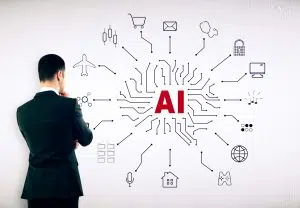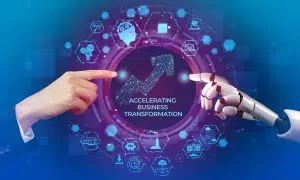Artificial Intelligence (AI) encompasses various technologies and techniques designed to simulate human-like intelligence and cognitive functions in machines. The “anatomy” of AI involves various components and concepts that work together to enable AI systems to perform tasks intelligently. Here’s an overview of the critical elements that make up the anatomy of AI: Data: Data is the lifeblood of AI. It includes structured and unstructured information, such as text, images, audio, etc. AI systems rely on large datasets for training and learning. Algorithms: AI algorithms are the core mathematical and computational instructions that enable AI systems to process and analyze data. These algorithms include machine learning, deep learning, reinforcement learning, natural language processing (NLP), and many more. Machine Learning: Machine learning is a subset of AI that focuses on developing algorithms that allow computers to learn and make predictions or decisions without being explicitly programmed. Standard techniques include supervised learning, unsupervised learning, and reinforcement learning. Deep Learning: Deep learning is a subset of machine learning that uses neural networks with multiple layers (deep neural networks) to process data. It is particularly effective for tasks like image and speech recognition. Neural Networks: Neural networks are inspired by the structure and function of the human brain. They consist of interconnected artificial neurons that process and transfer information. Convolutional neural networks (CNNs) and recurrent neural networks (RNNs) are standard in deep learning. Natural Language Processing (NLP): NLP is a subfield of AI that focuses on the interaction between computers and human language. It enables tasks like language translation, sentiment analysis, and chatbots. Computer Vision: Computer vision is the field of AI that enables machines to interpret and understand visual information from the world, such as images and videos. It’s used in applications like image recognition, facial recognition, and object detection. Speech Recognition: This technology enables machines to understand and transcribe spoken language. It’s used in voice assistants and voice command systems. Reinforcement Learning: Reinforcement learning is a type of machine learning that focuses on training AI agents to make a sequence of decisions to maximize a cumulative reward. It’s used in gaming, robotics, and autonomous systems. Big Data: AI often relies on large datasets for training and analysis. Big data technologies and tools, including distributed computing and storage, play a significant role in the AI ecosystem. Training Data: AI models require training data to learn patterns and make predictions. The quality and quantity of training data are critical factors in AI performance. Hardware: AI workloads can be computationally intensive. Specialized hardware, such as Graphics Processing Units (GPUs) and TPUs (Tensor Processing Units), are often used to accelerate AI training and inference. Cloud Computing: Many AI applications are deployed on cloud platforms, which offer scalability and accessibility to AI resources and services. Ethics and Bias Mitigation: As AI systems are trained on data, there is a growing emphasis on addressing bias and ethical considerations in AI development and usage. Robotic Process Automation (RPA): In AI, RPA automates rule-based tasks in business processes, often involving software bots. Decision-Making: AI systems are designed to make decisions or recommendations based on the patterns they’ve learned from data. User Interface: AI often interacts with users through chatbots, voice assistants, and recommendation systems. Regulation and Compliance: As AI technologies become more prevalent, there’s a growing focus on regulations and compliance related to AI, particularly in areas like data privacy and security. The anatomy of AI is diverse, incorporating various technologies, techniques, and considerations to enable machines to exhibit intelligent behavior and perform a wide range of tasks. It’s a rapidly evolving field with applications across industries. The anatomy of Artificial Intelligence (AI) can be divided into the following three main components: Hardware: AI systems need powerful hardware to process large amounts of data and perform complex calculations. This hardware can include CPUs, GPUs, and TPUs. Software: AI systems need software to implement AI algorithms and to interact with the real world. This software can include machine learning frameworks, deep learning libraries, and natural language processing tools. Data: AI systems need data to learn from. This data can come from various sources, such as sensors, databases, and the Internet. These three components work together to create AI systems that perform various tasks, such as image recognition, natural language processing, and machine translation. Here is a more detailed overview of each component: Hardware: AI systems need powerful hardware to process large amounts of data and perform complex calculations. This hardware can include: CPUs (central processing units): CPUs are general-purpose processors that can be used for various tasks, including AI. However, CPUs are less efficient than GPUs and TPUs for AI tasks. GPUs (graphics processing units): GPUs are designed for parallel processing, which makes them ideal for AI tasks. GPUs are typically much faster than CPUs for AI tasks. TPUs (tensor processing units): TPUs are specialized processors for machine learning. TPUs are typically much faster than GPUs for machine learning tasks. Software: AI systems need software to implement AI algorithms and to interact with the real world. This software can include: Machine learning frameworks: Machine learning frameworks provide tools and libraries for developing and training AI models. Popular machine learning frameworks include TensorFlow, PyTorch, and MXNet. Deep learning libraries: Deep learning libraries provide tools and libraries for developing and training deep learning models. Popular deep-learning libraries include Keras, PyTorch Lightning, and Hugging Face Transformers. Natural language processing tools: Natural language processing tools provide tools and libraries for processing and understanding human language. Popular natural language processing tools include NLTK, spaCy, and Hugging Face Transformers. Data: AI systems need data to learn from. This data can come from a variety of sources, such as: Sensors: Sensors can collect environmental data, such as images, videos, and audio recordings. Databases: Databases can store data about people, products, and other things. The Internet: The Internet is a vast data repository, including text, images, videos, and audio recordings. AI systems use data to learn patterns and to make predictions. The more data an AI system has, the







































































